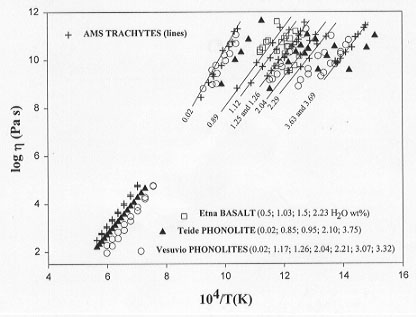

The diversity of magmatic behavior associated with volcanic processes ranging from effusive flows to explosive eruptions is evidenced by the wide variation of chemical composition observed in eruptive and post-eruptive products. In the present study we determined the viscosities of several alkaline composition natural melts. We investigated both anhydrous and hydrous silicate melts whose compositions vary from basaltic to rhyolitic and from trachytic to phonolitic. The samples we investigated originate from several important volcanic areas such as Etna, Phlegrean Fields, Vesuvius, Tenerife Island and Unzen. In particular, we measured the viscosities of anhydrous products from the Campanian Ignimbrite (trachyte), Astroni (peralkaline phonolite), Povocao (trachy-phonolite) and hydrated products from Agnano Monte Spina (alkali-trachyte), Monte Nuovo (alkali-trachyte), Etna (basalt) and Vesuvius 1631 (peralkaline phonolite) eruptions. We also include previously obtained results for a Teide phonolite. Concentric cylinder viscometry was carried out in the low viscosity range at high temperatures for the anhydrous melts. Piston cylinder syntheses were performed to hydrate many of the samples, and their viscosities were measured by the micropenetration method at low temperatures in the high viscosity range. FTIR analyses allowed for the determination of their water contents. A subset of the data obtained have been compared with those of previously investigated melts to span a wide compositional range (Fig. 3.5-9).
Unlike the anhydrous melts at high temperatures, the low-temperature data of the hydrous melts indicate evidence for a strong composition dependence of the activation energy for viscosity. This observation suggests that these liquids have varying degrees of fragility, or departure from Arrhenian behavior, over a greater range of temperature. Without the ability to determine the viscosities of these melts at higher temperatures due to loss of water during measurement, we have estimated the degree on non-Arrhenian behavior by approximating the data with the well-known Tammann - Vogel - Fulcher (TVF) equation, in which log η = A + B/(T-To). As a first constraint imposed on our anhydrous data, we required the fits to have positive values for To and B (proportional to the activation energy), and negative values for A, the shifting factor. The resulting values for A fell within the interval -3 to -7; this latter value corresponds to the minimum To=0 (equivalent to an Arrhenian expression). The final step consisted in using the hydrous melt viscosity data to constrain further the A parameter with a modified TVF equation with composition (water content) dependent variables B and To. This operation does not significantly affect the range of the resulting shift factor A (-4.2 to -6.4), suggesting that A is insensitive to water content. Finally, for similarly high water contents, we still observe significant differences in absolute viscosity (e.g. ~3.7 wt% H2O Teide vs Agnano Monte Spina), illustrating that compositional parameters other than water content still play important roles in affecting the absolute viscosities of these water-rich melts.
 |
Fig. 3.5-9: High-temperature (anhydrous melts) and low-temperature (hydrous melts) viscosities of Agnano Monte Spina (alkali-trachyte), Monte Nuovo (alkali-trachyte), Etna (basalt),Vesuvius 1631 (peralkaline phonolite) and Teide (phonolite) shown as function of reciprocal temperature. Water contents in wt% are given near the corresponding data. |

Tel: +49-(0) 921 55 3700 / 3766, Fax: +49-(0) 921 55 3769, E-mail: bayerisches.geoinstitut(at)uni-bayreuth.de
 Previous page
Previous page